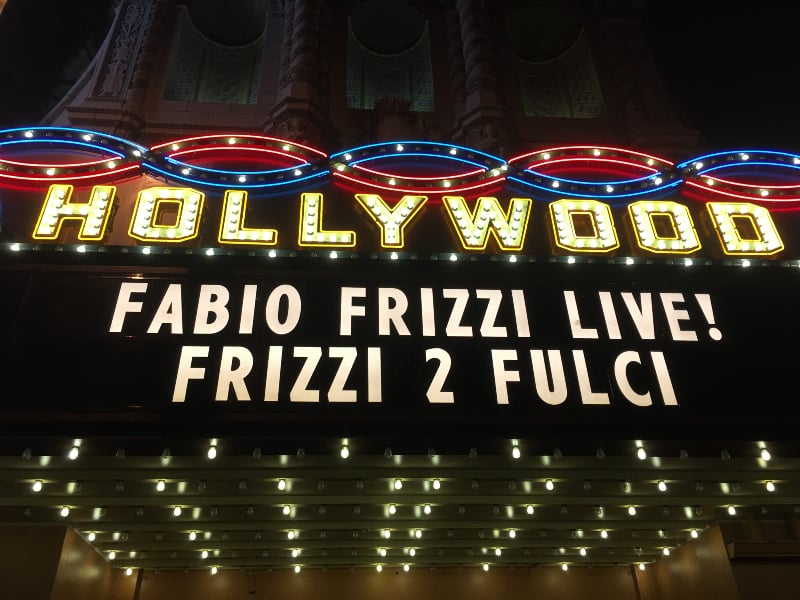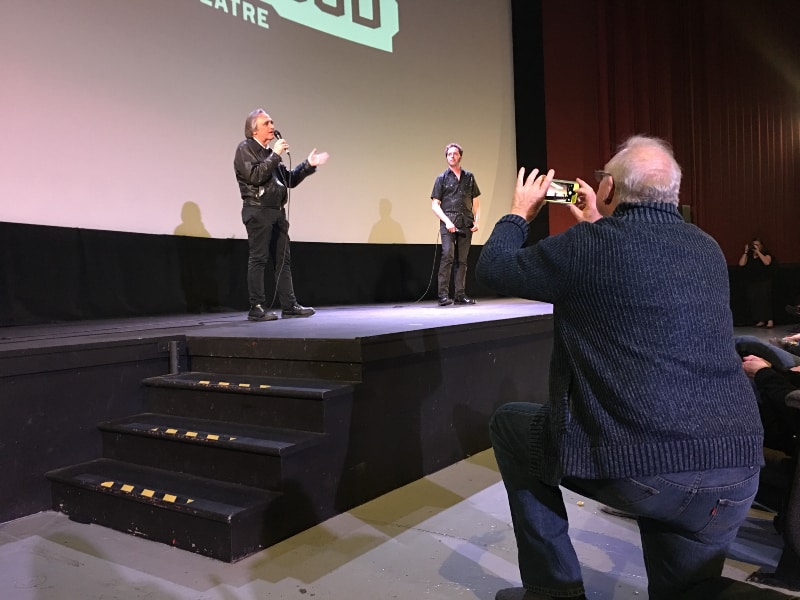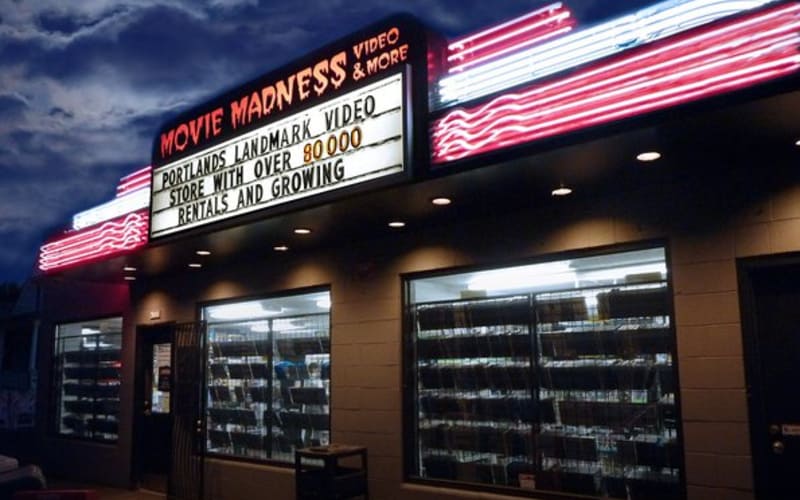Welcome to Back to the Movies, a special series of articles in which we’re exploring how we feel about returning to movie theaters after the pandemic. For this entry, Chris Coffel celebrates his favorite local landmark movie theater, Portland’s Hollywood Theatre.
On July 17, 1926, the Hollywood Theatre opened its doors in Portland, Oregon, with a screening of Albert Ray’s silent film More Pay – Less Work. At the time, it was a 1,500-seat theater with an eight-piece orchestra and organist. Designed by local architects Bennes & Herzog, the classic movie house was capable of showing films while also having a small stage for vaudeville performances. The theater was an instant hit, with moviegoers drawn in by the art deco design and glitzy marquee lights.
In the ninety-five years since that first showing, the theater has become a historic landmark and a community staple of the northeast Portland neighborhood that bears its name. But the Hollywood Theatre’s long-lasting success did not come easy, as it encountered many roadblocks along the way. Now, as it gears up to bounce back from the latest setback — the COVID-19 pandemic — we take a look at how “Portland’s premier modern-historic movie house,” a.k.a. the world’s most extraordinary movie theater, came to be.
The silent film era that birthed the Hollywood Theatre eventually gave way to talkies and it was forced to keep up. And early on, it did. In 1959, the venue made the jump to 70mm projection. Two years later, it became the first and only Cinerama theater in the state of Oregon. The most significant change came in 1975 when the theater underwent a major facelift. The balcony of the main auditorium was chopped up, creating two smaller screening rooms upstairs. The additional theaters opened more opportunities for the Hollywood Theatre, but the glamor began to fade. Despite being placed on the National Register of Historic Places in 1983, that decade was unkind as the famed picture house transitioned into a rundown fleapit.
The megaplex boom of the 1970s and 1980s took its toll. This influx of chain theaters coupled with the VHS and home video craze placed immense pressure on independent venues like the Hollywood Theatre. Audiences lost interest in the classic film formats, and the theater was in desperate need of a makeover. The theater never closed, but it slowly began to rot, and the glory days seemed all but gone. Then, Film Action Oregon, a Portland-based non-profit, stepped in to purchase the theater in 1997. This was the first official step in restoring the Hollywood Theatre’s beauty, but there was still much work to be done.
“The place looked like shit. It had horrible seats. It was completely rundown,” the cinema’s head programmer, Dan Halsted, told me when describing the previous state of the theater. “The screen was stained. The sound system was awful.”
The Hollywood Theatre was on the right track, but the improvements were slow coming. It wasn’t until 2011 that the theater started to see meaningful change. Doug Whyte joined the Hollywood Theatre board as the Executive Director and initiated a rebrand with an emphasis on community involvement. He also put Halsted in charge of programming.
“I had been a projectionist here before that, and then I was renting the theater out to show exploitation movies and kung fu movies and stuff. I just wanted to open my own theater, which was my plan,” Halsted explains. “The executive director knew that and made me the programmer and just let me do what I wanted.”
Even during its dark years, the Hollywood Theatre remained a vital part of the community. The building’s façade is instantly recognizable and serves as a landmark for anyone driving down Sandy Boulevard on Portland’s east side. The original 1920s design remains as a reminder of the glitz and glamour of the golden age of cinema, and the building’s silhouette is as iconic as that of Mount Hood. According to Halsted, Portlanders were eager to help the theater survive, but it had to offer them something they wanted. Building repairs would take time, but the theater was able to update the programming immediately.

Photo: Chris Coffel
The Hollywood Theatre took advantage of their three screens, making every night a special event while still hosting two first-run movies at a time. Halsted, a collector of film, emphasized celluloid, and the community responded positively. A series of fundraisers helped the restoration, allowing the Hollywood Theatre to get a new marquee, new seats, a new sound system, and a fresh coat of paint. The theater was even able to restore the original wood doors. With that 1926 sheen back in place, the Hollywood Theatre began to thrive once more.
Whenever possible, the Hollywood Theatre presents movies on film. Screenings of 35mm prints are a regular occurrence, complete with the hiss, pop, and imperfections that make every viewing unique. These showings also frequently include guests ranging from actors and directors to composers who perform live scores. And in 2015, the theater brought back the lauded 70mm projection while the two smaller theaters upstairs are equipped for 16mm.
The Hollywood Theatre takes full advantage of these capabilities with what they have dubbed their Signature Film Series, which consists of a diverse range of titles curated by staff, community programmers, and partner organizations. No matter your interest, the Hollywood Theatre very likely has you covered. Fashion in Film is a regular series programmed by Eden Dawn featuring films that have influenced the curator’s sense of style. Past screenings have included Grey Gardens, Don’t Tell Mom the Babysitter is Dead, and Poison Ivy.
Maybe you want to go to the movies but enjoy television? If that’s the case, then Re-Run Theater is for you. Programmed by the Phantom Hillbilly, this series takes the weirdest, most bizarre television shows and made-for-TV movies from yesteryear and presents it on the big screen, complete with commercials. It’s a trip worth taking.
Queer Horror is a personal favorite of mine. This bimonthly series hosted by Portland’s premier drag clown Carla Rossi highlights “genre works by queer artists, performers, and filmmakers questioning horror’s relation to queerness and what it means to identify with the monster.” Rossi often introduces the films with some pre-show entertainment. For example, the Pride special screening of Drop Dead Gorgeous — a slasher, according to Rossi — opened with a drag pageant featuring Portland’s fiercest queens. The Babadook took home the crown that evening. And Queer Horror events are always accompanied by special works from talented Portland artist Jason Edward Davis.
The most popular series the theater runs is Halsted’s own Kung Fu Theater. He has dedicated his life to saving these films and presenting them to modern audiences. Every film showcased is a Hong Kong action film from the ’70s or ’80s and is always presented in 35mm. Often prints shown are the only ones known to exist. On really special occasions, a guest will be present, as with the time director Brian Trenchard-Smith stopped by to introduce and discuss his classic film The Man from Hong Kong.
It’s not unusual to see someone like Trenchard-Smith hanging around the Hollywood Theatre even when his films aren’t playing either. Since relocating to a town just outside of Portland, he has become a regular attendee. I once snapped a photo of Trenchard-Smith taking a picture of Joe Dante during a post-screening Q&A of the greatest movie ever made, The ‘Burbs.
“The Hollywood Theater is a cineaste’s paradise,” raved Trenchard-Smith when I asked him about the theatre. “Offering a full menu, from 70mm revivals, kung fu classics, arthouse, and mainstream releases served with a slice of pizza and an IPA. It’s a uniquely Portland institution. I always enjoy Dan Halsted’s Q&As.”

Photo: Chris Coffel
The 70mm screenings have become an audience favorite since returning with Stanley Kubrick’s masterpiece 2001: A Space Odyssey. The format has seen high demand, with virtually all showtimes selling out. And the selection has been a good mix of modern classics like Roma and Phantom Thread and beloved favorites like Vertigo and The Dark Crystal. The theater hosted sixty screenings during the original theatrical fun of Quentin Tarantino’s The Hateful Eight, selling out each one. On one special night, Tarantino even made an unannounced visit, introducing the movie to a surprised audience.
The 70mm format isn’t reserved for the so-call “prestige” films either. Over the years, the Hollywood Theatre has wowed Portland audiences with 70mm screenings of Lifeforce, Howard the Duck, and Streets of Fire. One of my all-time favorite moviegoing experiences is seeing John Carpenter’s The Thing in all the glory of 70mm. You haven’t really experienced Rob Bottin’s groundbreaking effects until you’ve experienced them in the wide high-resolution of 70mm.
In 2017, the Hollywood Theatre proved their love of film goes beyond the theatrical experience. When Portland’s beloved video rental store Movie Madness was on the verge of going out of business, the Hollywood Theatre stepped up to save the day. With the community’s help, the theater raised the necessary funds to purchase the video store, absorbing its collection of more than eighty-thousand titles under the Hollywood Theatre non-profit banner. Since the purchase, the theater has expanded Movie Madness to include the Movie Madness Miniplex. This mini-theater includes a wide variety of programming, including educational events, and is available for private screenings.

Photo: Nate Ashley (courtesy of the Hollywood Theatre)
That same year, the Hollywood Theatre took their love of movies to the Portland International Airport with the opening of a microcinema. This mini-plex features a miniature version of the theater’s iconic marquee and offers travelers the chance to take in Oregon-made movies for free while waiting to catch their flight. It’s a unique experience that makes the airport a lot more bearable.
Unfortunately, like the rest of the world, the Hollywood Theatre came to a screeching halt in March 2020. The in-door screenings were placed on pause, and the theater closed indefinitely. But it did not let up. The Hollywood Theatre launched Movie Madness University: Online, a virtual education program hosted by film experts.
Hollywood at Home was another pandemic-era addition. The Hollywood Theatre took this opportunity to help us all get through stay-at-home orders by offering at-home movie recommendations courtesy of theater staff, curators, and special guests. The theater recently partnered with The Lot at Zidell Yards to program a summer series of pop-up outdoor screenings. Upcoming films include Crazy Rich Asians, Troop Beverly Hills, and Labyrinth.
Halsted has stayed busy, promoting the Hollywood Theatre’s spirit by joining the Pure Cinema Podcast to discuss his love of kung fu movies with Quentin Tarantino. If you want to get an idea of what it’s like to attend one of Halsted’s screenings, this podcast is a good starting point. To fully immerse yourself, you’ll also want to visit 36 Cinema. Halsted teamed with the de facto leader of the Wu-Tang Clan, RZA, to keep Kung Fu Theater alive with the Hollywood Theatre closed. The kung fu nerds provide commentary on a series of classics, such as Five Deadly Venoms and Mystery of Chessboxing.
Recently, the Hollywood Theatre announced plans to reopen in early July, and that’s exciting news for film lovers in the Pacific Northwest. The idea of what cinema is and how we consume it is constantly evolving. Movie theaters and physical media are frequently talked about in the past tense, with streaming and digital consumption hailed as the wave of the future.
The Hollywood Theatre is selling something different, however. This movie theater harkens back to the golden age of cinema and treats going to the movies like a special occasion. And the theater does so by reminding us that you can respect the impact films can have while still having fun. One night you can attend a screening of Selena as part of a Social Justice Film series, followed by a discussion about the cultural importance of the film. And the next night, you can enjoy a 35mm screening of Umberto Lenzi’s Nightmare City at 3:30 AM with two hundred other horror-loving maniacs.
With the world slowly beginning to reopen and many of us hoping to return to some sense of normalcy, places like the Hollywood Theatre are all the more important. I, for one, cannot wait to return. Here’s to another ninety-five years of celebrating cinema with the Hollywood Theatre.




0 comments:
Post a Comment